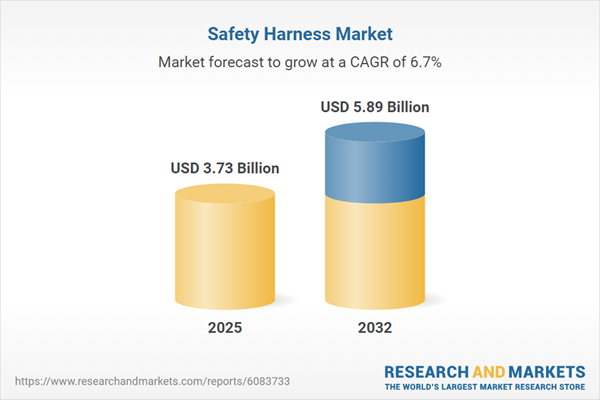Speak directly to the analyst to clarify any post sales queries you may have.
Senior executives navigating high-risk industrial environments require advanced solutions to protect their workforce and ensure operational continuity. The safety harness market is experiencing significant transformation, driven by technology, regulations, and global supply chain shifts.
Market Snapshot: Safety Harness Market Size, Growth, and Outlook
The safety harness market grew from USD 3.50 billion in 2024 to USD 3.73 billion in 2025 and is expected to continue at a CAGR of 6.72%, reaching USD 5.89 billion by 2032. This expansion reflects increasing prioritization of worker protection across construction, manufacturing, oil and gas, and energy sectors. Regulatory enhancements, technological advances, and the growing adoption of smart harness systems are shaping purchasing decisions and market opportunities for B2B stakeholders.
Scope & Segmentation of the Safety Harness Market
This report provides a deep dive into critical industry segments and regional dynamics, outlining the breadth of applications and purchasing behaviors influencing the market:
- Product Type: Fall arrest harness (five-point and four-point configurations), positioning belts (adjustable and non-adjustable), seat belt harness, suspension harness.
- Application: Commercial construction, infrastructure construction, residential construction, manufacturing, oil and gas, transportation.
- End User: Construction companies, manufacturing plants, mining companies, oil and gas companies, utilities.
- Distribution Channel: Distributors, retailers, e-commerce platforms, manufacturer websites.
- Material: Nylon, polyester, steel.
- Regional Coverage: United States, Canada, Mexico, Brazil, Argentina, Chile, Colombia, Peru, United Kingdom, Germany, France, Russia, Italy, Spain, Netherlands, Sweden, Poland, Switzerland, United Arab Emirates, Saudi Arabia, Qatar, Turkey, Israel, South Africa, Nigeria, Egypt, Kenya, China, India, Japan, Australia, South Korea, Indonesia, Thailand, Malaysia, Singapore, Taiwan.
- Leading Companies: 3M Company, Honeywell International Inc., MSA Safety Incorporated, Illinois Tool Works Inc., Safariland Group, Delta Plus Group SA, Teufelberger AG.
Key Takeaways for Senior Decision-Makers
- Continued innovation in harness design, including the integration of ergonomic materials and digital sensor technologies, is enhancing workforce safety and user comfort.
- Regulatory tightening across major geographies is elevating baseline safety requirements, compelling procurement teams to prioritize certified and compliant harness solutions.
- Material selection is now a strategic focus, with buyers assessing not only durability but also environmental and task-specific compatibility to optimize performance and total cost of ownership.
- Hybrid distribution networks—combining robust offline presence with customizable online platforms—allow for responsive supply and streamlined training, supporting efficient equipment rollouts.
- Application and end-user trends reveal growing demand for modular, sector-specific harness configurations, as organizations expand safety programs to cover increasingly complex job site requirements.
- Industry partnerships, research collaborations, and acquisitions are shaping competitive advantage by enabling broader product portfolios and more agile responses to client needs.
Tariff Impact on Cost Structures and Sourcing Strategies
Recent United States tariff policies have introduced cost volatility into the safety harness supply chain, affecting sourcing of key materials like high-strength steel and synthetic fibers. Market participants are adapting by pursuing alternative materials and diversified suppliers, realigning procurement strategies to ensure continuity and regulatory compliance. Distributors are responding by recalibrating pricing structures and managing preemptive purchase surges, emphasizing the necessity for agile supply chain planning in a rapidly evolving trade environment.
Methodology & Data Sources
This analysis is grounded in primary interviews with safety officers, procurement experts, and compliance professionals, supplemented by secondary research from regulatory bodies, technical white papers, and laboratory assessments. Scenario modeling and peer review ensure accurate, actionable insights for senior decision-makers.
Why This Report Matters
- Empowers executives with intelligence to optimize safety investments and achieve regulatory alignment in complex operating environments.
- Equips procurement and operations teams to anticipate market shifts, manage risk, and make informed materials or sourcing decisions amid changing trade policies.
- Supports innovation and continuous improvement by benchmarking competitors and tracking technological adoption across global markets.
Conclusion
The safety harness market is advancing in response to regulatory, technological, and operational shifts worldwide. Informed strategies that align procurement, compliance, and innovation will be critical to achieving sustainable growth and robust workforce safety outcomes.
Table of Contents
3. Executive Summary
4. Market Overview
7. Cumulative Impact of Artificial Intelligence 2025
Companies Mentioned
The companies profiled in this Safety Harness market report include:- 3M Company
- Honeywell International Inc.
- MSA Safety Incorporated
- Illinois Tool Works Inc.
- Safariland Group, Inc.
- Delta Plus Group SA
- Teufelberger AG
Table Information
| Report Attribute | Details |
|---|---|
| No. of Pages | 198 |
| Published | November 2025 |
| Forecast Period | 2025 - 2032 |
| Estimated Market Value ( USD | $ 3.73 Billion |
| Forecasted Market Value ( USD | $ 5.89 Billion |
| Compound Annual Growth Rate | 6.7% |
| Regions Covered | Global |
| No. of Companies Mentioned | 8 |









